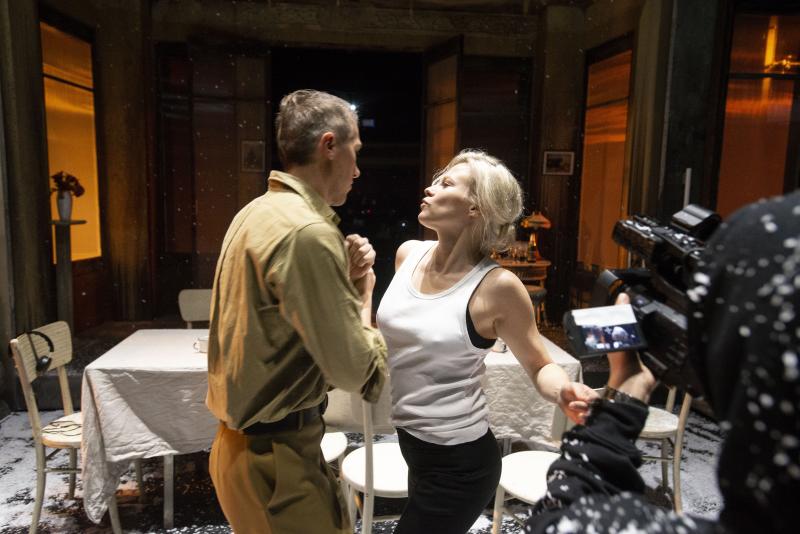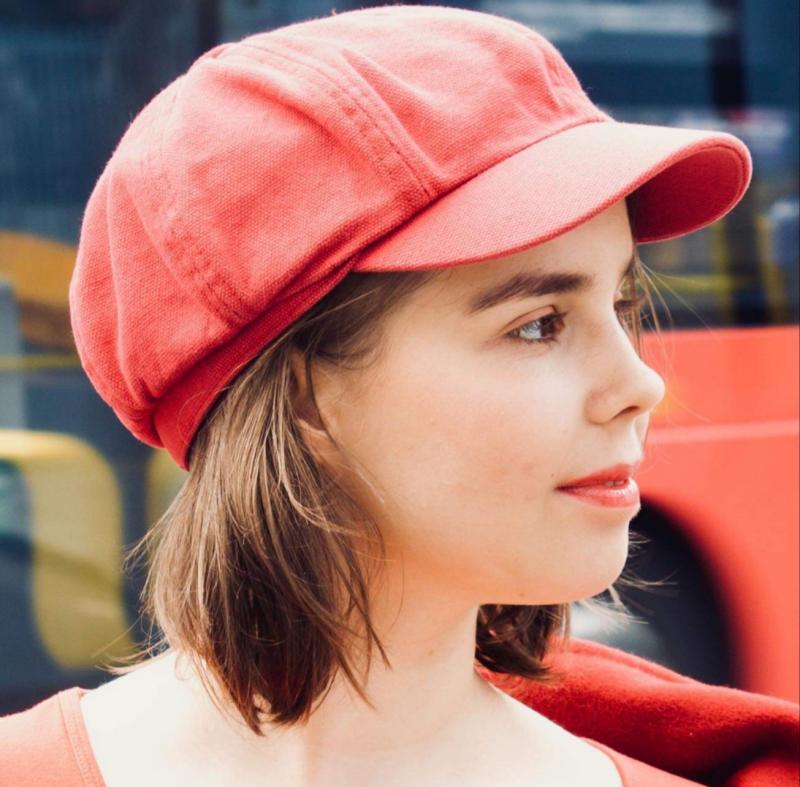Review and analysis: CHEKHOV'S THREE SISTERS at the Finnish National Theatre

Eero Ritala, Emmi Parviainen and Elena Leeve
Projections.
Massive set designs. Intensive acting. Symbolism. Paavo Westerberg's Three Sisters at the Finnish National theatre is extremely ambitious, a little crazy and might be too much for people with sensory processing sensitivity (SPS).
Spoiler warning.
The show is opened up with three cats peeking from behind the curtain, singing and welcoming people to the show. That itself emphasizes the fact that we're here seeing fiction, something imagined, a relfection of reality. The performance seeks to know what is real and reality.
We can feel the rumbling in our seats, which brings just the right atmosphere. But then the hustle starts as the curtains are pulled: the stage rotates around a huge mansion with furnitures and decorations in it, which I wish to examine with my eyes. But then there comes something else too: a screen with the faces of the sisters, and their introductions projected. Happenings that simultaneously happen on stage too. So up to this point we've been offered over 6 things to look at, counting only the doubled sisters on stage and screen, not to mention the rotating mansion and its details and other things going on.
Two of the sisters (Elena Leeve as Olga and Marja Salo as Irina) start explaining the backstory. I myself got a hung of the fact that they're even speaking, though I saw their mouths moving, after about one minute or so. And the fact that their father has died-- that one I missed out completely. There was just too much to process, especially for a person like me who tries to see and connect every single detail on stage. Every movement and gesture and placement of the characters speak, and my eyes always turn towards the slightest movement or happening I can see. "Sensory processing sensitivity (SPS) involves an increased sensitivity of the central nervous system and a deeper cognitive processing of physical, social and emotional stimuli. The trait is characterized by a tendency to 'pause to check' in novel situations, greater sensitivity to subtle stimuli, and the engagement of deeper cognitive processing strategies-- all of which is driven by heightened emotional reactivity, both positive and negative", an edited quote from Wikipedia. So, I personally got nervous because of all the visual stimuli. It took time to get used to the style, which on my part happened only at the moment when they ended up talking about the onions, so after about 40 minutes I'd say. Only then I noiced myself settling down and getting to the flow of the storytelling.

The projections by Ville Seppänen are a big part of the play. Westerberg's version of the play is set in the early 2000s and the projections contain various clips of the time's technological and environmental development, to put it shortly. There are other absurd details too, when for example Furries get their little representation on the TV screen and on the ground in one video we can see Fortnite magazines. "Life can be chaotic", ponders Kulyginia (Tuomas Tulikorpi) in the second act and so can this performance. In the scene where Andrei (Eero Ritala) had his fancy Russian rap scene, the projections were the most integrated and fit due to the strong music and Ritala's aggressive attitude. Also the lightnings behind the kiss scene with Tusenbach (Olavi Uusivirta) and Irina (Marja Salo) worked out well. It was one of my favorite scenes because of its overly acted, absurd, love-high filled moments from Uusivirta and Salo before it. They laid the perfect foundation for the coming lightnings.
"Life can be chaotic", ponders Kulyginia (Tuomas Tulikorpi) in the second act and so can this performance.
The live-videos have been Westerberg's trademark for quite a while and were clearly well choreographed in this show too. But as I said before, there were at times too much to follow. One of the most relieving moments was when on screen the three different projections turned into three equal projection of one live-video, video of Emmi Parviainen as Masha. It was much easier to follow. It wasn't that bad either when Jussi Vatanen as Veršinin was in the middle and the projection of the sisters were on both sides. By the way, in that scene it was so beautiful when you were able to recognise the sisters from each other just in that one still moment, to see that who's who; youngest, oldest and the middle one, just by how they were and stood there! Incredible. The videos were best in the scenes when they went "hand in hand" with the stage scenes, for example when Veršinin (Jussi Vatanen) pointed at the sisters, and the other camera view moved like his finger would have. Also when Irina (Marja Salo) vanished from the screen and we began to search for her on the stage, only seeing the back wall of the mansion. But in a few seconds, Irina opens up the door and comes through it! To give an expectation and to fill it, it's beautiful and good. Also when Soljony (Samuli Niittymäki) shoots Tuzenbach (Olavi Uusivirta) in the end was a scene very well done.
.jpg)
I don't say I didn't enjoy the live-videos, I did, when they had their right purpose and place. For example when Anna-Maija Toukko as Nataša was described by others, and the camera holder sneaked into the upper room where she and her lover Andrei (Eero Ritala) were: "That woman, how she dresses up..." was heard, and in the video we were able to see and view her outfit that was filmed up close. Also, it was good that the actors did a small, distinct physical movement, most of the times before or after the introduction of the names of the characters. In those moments the live-film got paused, which was very enjoyable. Westerberg must be a real cinema lover too, because in the show we saw both a bountiful scene of iconic cinema kisses (which was a little too much and not fitting in my opinion) and a classic twist scene from Pulp Fiction, remade on stage. Also I couldn't help but think about The Office tv-series at the first zoom towards the face of Eero Ritala as he looked directly into the camera.
The actors clearly had fun on stage, especially in the scenes where they admired the frames together: "Look at these frames!" The show had also some nifty and enjoyable scenic details, for example when Samuli Niittymäki as Soljonyi drops onto the ground from the rails he's been working out on, and in the same time Olavi Uusivirta as Tuzenbach plays the piano from the highest note to the lowest, which makes a falling sound-effect.
The second act after the interval had a little more realness to it. The first act was so rigorously filled with all the projections and tricks that I felt that the sheer potential hid itself a little behind all the overwhelmness of good ideas, lacking honesty. But could it have been the whole point?
The first act was so rigorously filled with all the projections and tricks that I felt that the sheer potential hid itself a little behind all the overwhelmness of good ideas, lacking honesty. But could it have been the whole point?
The deep analyse part: The dramatic decisions and hints, from the huge projections in the second act of the whole stage-- on stage-- to the Teletubbies on the TV screen spoke about reality. In Teletubbies the audience also gets sucked into another reality through their tummy TV:s, which might have been a distant reference to the first act's live-videos and everything else, those distractions of the moment, distractions of the now. And in the second act the negative-colored projections of the stage onto the stage emphasized the moment that was lived.
The chairs are being thrown away; the support is being thrown away. The whole house is shaking and being lifted up; the character's certainity in the safe and sure things are shaking and lifted up, not giving them shelter.
The synced running in place reminded me of London's National Theatre's Jane Eyre. The hiding of Kulyginia (Tuomas Tulikorpi) was a perfect, humane moment after all the gloom.
Finally, at the very end of the play Tšebutykin (Esko Salminen) shouts "Everything is meaningless" at the distant sisters who seem to wait and gaze upon the stairs of heaven. "If we only got to know", is being answered back at him.
If we only got to know whether everything is meaningless.
All in all the Three Sisters at the Finnish National Theatre is intense, absurd and really ambitious piece that left me a little confused and nervous after all the stimulus and dramatical hints that weren't all that clear and graspful. Nevertheless, it's definitely a show worth seeing, especially if you're into modern, technical side of the theatre. Or Paavo Westerberg's style. Or any of the fine actors.
More info and tickets here.
Three Sisters (Kolme Sisarta) at the Finnish National Theatre.
On stage: Elena Leeve, Samuli Niittymäki, Terhi Panula, Emmi Parviainen, Eero Ritala, Esko Salminen, Marja Salo, Tuomas Tulikorpi, Anna-Maija Tuokko, Olavi Uusivirta and Jussi Vatanen. Director: Paavo Westerberg. Set Design: Markus Tsokkinen. Costume Design: Anna Sinkkonen. Lightning Design: Pietu Pietiäinen. Music and sound design: Sanna Salmenkallio. Projection- and video design: Ville Seppänen. Make Up: Laura Sgureva. Dramaturg: Eva Buchwald. Director's assistant: Joel Härkönen
Photos: Tuomo Manninen
Article: Rosanna Liuski

Reader Reviews

Videos

